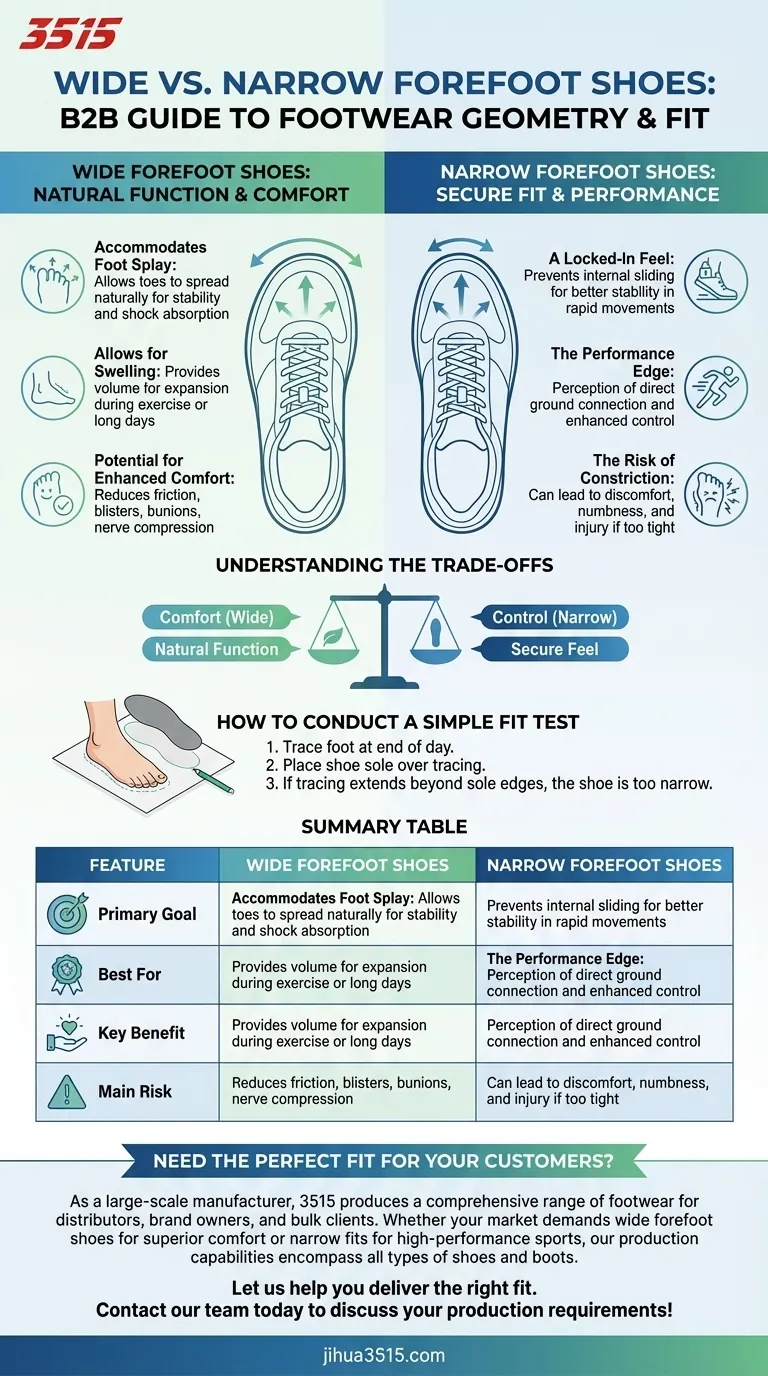The fundamental difference between wide and narrow forefoot shoes lies in their core design philosophy: accommodating natural foot mechanics versus providing a secure, performance-oriented lockdown. Wide forefoot shoes are built to allow your toes to spread and your foot to expand naturally under load. In contrast, narrow forefoot shoes are designed to hold the foot snugly, minimizing internal movement for a more responsive feel.
Choosing the right forefoot width is not about finding a universally "better" shoe. It is about aligning the shoe's geometry with your foot's unique shape and the specific demands of your activity.

The Case for Wide Forefoot Shoes: Prioritizing Natural Function
Accommodating Foot Splay
Your feet are designed to spread, or "splay," when they bear weight. This is a natural shock absorption and stability mechanism. A wide forefoot allows this to happen without restriction.
Allowing for Swelling
Throughout the day, and especially during exercise, feet naturally swell. A wider design provides the necessary volume to accommodate this expansion, preventing excessive pressure and discomfort.
Potential for Enhanced Comfort
By giving your toes room to move freely, wide forefoot shoes can significantly reduce the risk of friction, blisters, bunions, and nerve compression.
The Case for Narrow Forefoot Shoes: Emphasizing a Secure Fit
A Locked-In Feel
For activities involving rapid cuts or lateral movements, a snug fit can be advantageous. It prevents your foot from sliding inside the shoe, which can improve stability and responsiveness.
The Performance Edge
Some athletes prefer a tighter forefoot because it can feel like a more direct connection to the ground or pedal. This perception of enhanced control is often a key factor in performance footwear.
The Risk of Constriction
The primary drawback of a narrow forefoot is its potential to compress the foot. If the shoe is too narrow for your foot shape, it will inevitably lead to discomfort and potential injury.
Understanding the Trade-offs
Comfort vs. Control
The choice often boils down to a trade-off between natural comfort and a feeling of precise control. A shoe that allows your foot to function naturally may feel less "secure" to someone accustomed to a tight fit.
The Myth of "Support"
Do not confuse a tight, narrow fit with good support. True anatomical support comes from a shoe's midsole and heel structure, not from squeezing your forefoot. A shoe that is too narrow can actually compromise your stability by preventing your toes from splaying.
How to Conduct a Simple Fit Test
A reliable way to check if a shoe is too narrow is the tracing method.
At the end of the day, when your feet are at their largest, trace your foot on a piece of paper. Place the shoe you are considering over the tracing. If the outline of your foot extends beyond the edges of the shoe's sole, the shoe is too narrow for you.
Making the Right Choice for Your Goal
Ultimately, the best choice depends entirely on your anatomy and intended use.
- If your primary focus is all-day comfort, walking, or general fitness: Lean towards a wider forefoot shoe that respects your foot's natural shape and movement.
- If your primary focus is a performance sport with frequent, rapid directional changes: A snugger fit might be beneficial, but you must ensure it doesn't cause pain or constrict your toes.
- If you regularly experience numbness, blisters, or rubbing on the sides of your feet: This is a clear indicator that your current shoes are too narrow and you should explore wider options.
Trust the feedback from your own feet to guide you to the correct balance of space and security.
Summary Table:
| Feature | Wide Forefoot Shoes | Narrow Forefoot Shoes |
|---|---|---|
| Primary Goal | Accommodate natural foot splay and swelling | Provide a secure, locked-in fit |
| Best For | All-day comfort, walking, general fitness | Performance sports with rapid directional changes |
| Key Benefit | Enhanced comfort, reduces blisters/bunions | Perceived stability and responsive feel |
| Main Risk | May feel less "secure" or precise | Can cause constriction, pain, and numbness |
Need the Perfect Fit for Your Customers?
As a large-scale manufacturer, 3515 produces a comprehensive range of footwear for distributors, brand owners, and bulk clients. Whether your market demands wide forefoot shoes for superior comfort or narrow fits for high-performance sports, our production capabilities encompass all types of shoes and boots.
Let us help you deliver the right fit. We can provide the perfect footwear solutions to meet your customers' specific needs.
Contact our team today to discuss your production requirements!
Visual Guide

Related Products
- Safety Footwear Wholesale Manufacturer for Custom OEM/ODM Production
- Wholesale Durable Breathable Safety Boots Custom OEM Manufacturer
- Wholesale Safety Footwear Manufacturer for Bulk & Custom OEM Orders
- Premium KPU Injection Athletic Style Safety Shoes
- Wholesale Customizable Safety Boots Durable & Protective Footwear Manufacturing
People Also Ask
- How do safety shoes contribute to cost savings for companies? A Strategic Investment in Risk and Cost Management
- What are OSHA approved shoes? Understanding the Correct Standards for Workplace Safety
- Do snake bite boots work? Your Ultimate Guide to Effective Snake Bite Protection
- What are the differences between steel toe, composite toe, and alloy toe Wellington boots? Choose the Right Safety Toe for Your Job
- How long can you wear safety boots? The Lifespan is Determined by Wear, Not Time



















